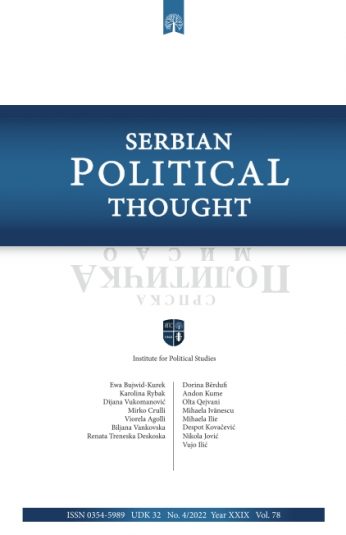Main topic
spt2/2013
Geopolitical Processes and Ethnodemographic Changes in Serbia in the Late XX and Early XXI Century
Abstract
In this paper will be presented the ethnic picture of the population of the Serbia and the ethnodemographic changes in period 1991-2002, caused by geopolitical processes, migration, natural movement, changed declaration on national affiliation, as well as some political and socio-economic factors. Ethnocentric migrations (voluntary and forced) primarily influenced on the change of ethnic structure of the Serbia, in the sense of creating nationally more homogeneous region, having in mind the national structure of refugee-population. On the other side, the emigration of some other nationalities which migrated to their mother countries due to political and economic reasons influenced on the ethnic structure, too. Spatial distribution of population according to nationality is an important aspect of demographic development conditioned primarily by ethnically differentiated natural growth and migrations, but also with the impact of numerous other factors. In Serbia is present an exceptional concentration and homogenization of population of certain nationalities. Due to specific territorial distribution and ethnic domination of relevant national minorities in border parts of the country, the question of their status and territorial-political organization gives special severity and significance to the minority question in Serbia. Having in mind that Serbia is a multiethnic and multiconfessional state, the protection of minorities rights and good inter-ethnic relations are necessary for peace, stability and democratic development of the Serbia and the Balkans region.
References
- Brunner, G. (1994) “Nation-States and Minorities in the Eastern Part of Europe”, A Review of Minoritiy and Ethnic Studies , 67-71.
- Cvijić, J. (1966) Balkansko poluostrvo i južnoslovenske zemlje. Beograd: Zavod za izdavanje udžbenika.
- Gagic, Lj. (2009) “Etnički procesi stanovništva Novog Pazara u drugoj polovini XX veka”, Demografija, pp. 54-62.
- Haug, W., Courbage, Y. and Compton, P. (1998) “The Demographic Characteristics of National Minorities in Certain European States”, Population Studies, 1(30): 2-24.
- Janjić, D. (1995) ”Minorities Under the Rule of Nationalism: The Case of Yugoslavia”. In: Bianncini, S., Janjic, D. (eds.) Nationalism and Minorities. Belgrade: Forum for Ethnic Relation, Institute of Social Sciences. pp. 24-33.
- Petrović, R. (1983) ”Dugoročne promene etničke strukture u SR Srbiji”, Zbornik Filozofskog fakulteta, XIII (2): 43-51.
- Poulton, H. (1991) “Balkans-Minorities and States in Conflict”, Minority Rights Publications, 1-35.
- Raduški, N. (2009) “Obrazovanje kao ključ za integraciju Roma u društvo”, Politička revija, 19(1): 189-205.
- Raduški, N. (2007) “Nacionalne manjine u Centralnoj Srbiji – etničke promene i demografski razvoj”. Beograd: Institut društvenih nauka.
- Raduški, N. (2011) “Demografske komponente nacinalnog identiteta”, Srpska poltička misao, 31(1): 321-336.
- Raduški, N. (1996) ”Ethnic Composition of the Population of the FR of Yugoslavia, 1948-1991”. In: Janjić, D. (ed.) Ethnicity in Postcommunism. Belgrade: Forum for Ethnic Relation and Europe and the Balkans, pp. 44-55.
- Rady, M. (1995) “Minorities Right and Self Determination in Contemporary Eastern Europe“. In: Bianncini, S., Janjic, D. (eds.) Nationalism and Minorities. Belgrade: Forum for Ethnic Relation, Institute of Social Sciences, pp. 24-33.
- Spasovski, M. (1994) “Teritorijalni razmeštaj naroda i nacionalnih manjina u SR Jugoslaviji”, Jugoslovenski pregled, XXXVIII (1): 27-39.
- Wiberg, H. (1996) “Ethnicity, Identity, Conflict”. In: Janjić, D. (ed.). Ethnicity in Postcommunism. Belgrade: Forum for Ethnic Relation and Europe and the Balkans, pp. 61-77.
- Yacoub, J. (1998) Les minorités dans le monde – faits et analyses. Paris : Desclée de Brouwer


